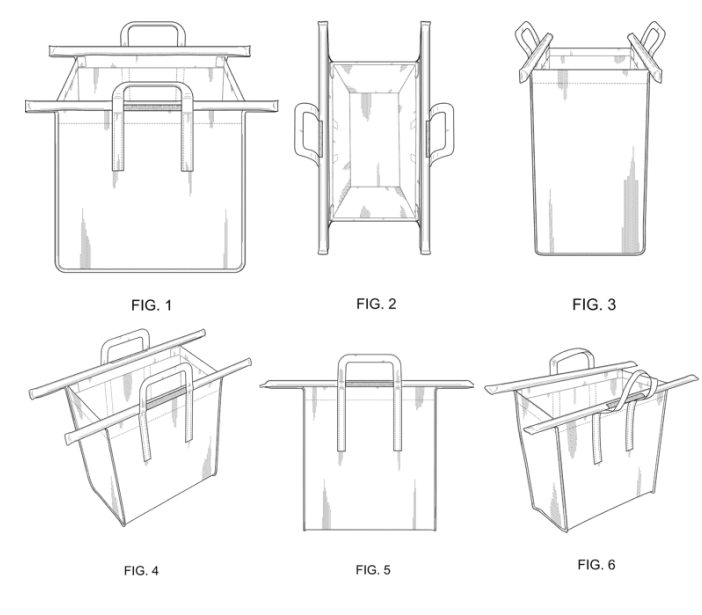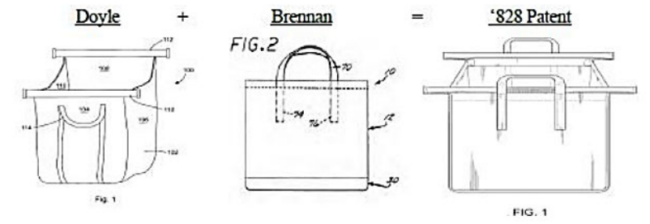Did not receive verification mail? Please confirm whether the mailbox is correct or not Re send mail

IPR Daily
- 2022-06-23 11:23:45
Design Patent: Invalid as Unduly Functional
Does the patent cover the "best design;"
Would alternative designs adversely affect the article's utility;
Are there parallel utility patents;
Does the advertising tout features as having utility;
Are there any elements that are clearly ornamental – i.e., "clearly not dictated by function."

Evo's design patent claims an "ornamental design for a foldable bag" as shown in the figures above. This style of bag is known as a "trolly bag" in the UK and is used in shopping carts (trollies) to maintain order in reusable fashion.

After receiving a threat letter, Golden Eye filed a declaratory judgment action and won on summary judgment. In particular, the S.D.Ca. district court held the patent invalid as both functional and obvious; and also not infringed.
Functionality: Design patents focus on ornamentality rather than utility. But, this divide quicky become confusing. Although the design must be ornamental, it is simultaneously a "design for an article of manufacture." I.e., typically a design for a useful item. The Federal Circuit has attempted to police this divide in a number of cases — trying to discern whether the design is unduly functional (and thus unpatentable as an ornamental design). Certainly, a design falls on the unduly functional side if its patent excludes all possible forms of the article of manufacture in question. A step further, the court has concluded that a design "dictated by the utilitarian purpose of the article" is not protectable by a design patent. High Point Design LLC v. Buyer's Direct, Inc., 730 F.3d 1301 (Fed. Cir. 2013). In several cases, the court has recited a list of additional factors to consider:
See Berry Sterling Corp. v. Pescor Plastics, Inc., 122 F.3d 1452 (Fed. Cir. 1997). Although functionality is a question of fact, the Federal Circuit affirmed that summary judgment was appropriate — finding "no issues of material fact precluding summary judgment."
Of these factors, the most important appears to be the availability of alternative designs. The quirk with that key factor is that the burden will be placed on the patentee to present those alternative designs even though the patent is presumed valid.
Obviousness: The court also affirmed on obviousness grounds — finding that an Irish patent filing by Trolly Cart founder (Doyle) created the same overall impression and that the only real difference in cloth handle length that was shown in other prior art bags.

Again, the appellate panel found that summary judgment of obviousness was appropriate. Obviousness is a question of law based upon underlying factual conclusions and summary judgment is appropriate when "the content of the prior art, the scope of the patent claim, and the level of ordinary skill in the art are not in material dispute."
Source: patentlyo.com-Dennis Crouch
Editor: IPR Daily-Selly
- I also said the two sentence
- Also you can enter 140words
 TOP IPR U.S. Lawyers 10 & Firms 10 Selection Officially Launched by IPR Daily
TOP IPR U.S. Lawyers 10 & Firms 10 Selection Officially Launched by IPR Daily WIPO Global Innovation Index 2025: China Enters Top 10
WIPO Global Innovation Index 2025: China Enters Top 10 Singapore ranks 5th in the 2025 Global Innovation Index; climbed two spots in Innovation Outputs
Singapore ranks 5th in the 2025 Global Innovation Index; climbed two spots in Innovation Outputs Federal Circuit lacks jurisdiction over award that doesn’t raise issue of patent law
Federal Circuit lacks jurisdiction over award that doesn’t raise issue of patent law


